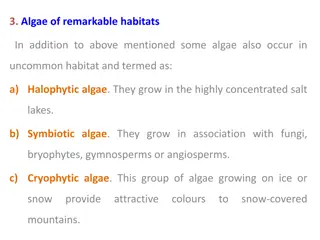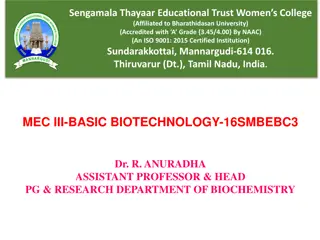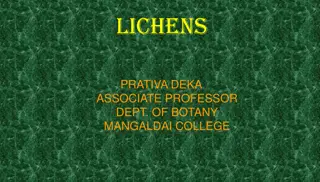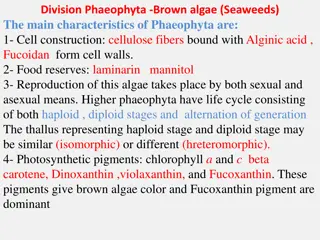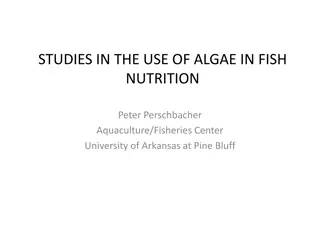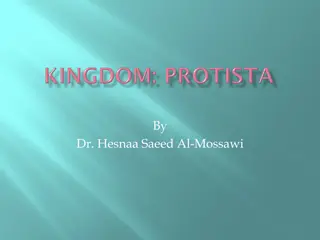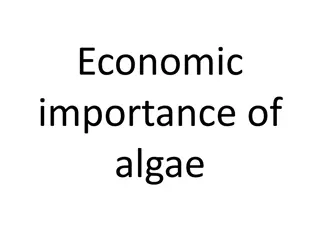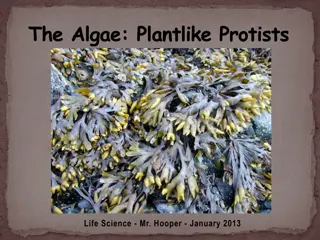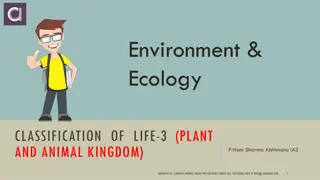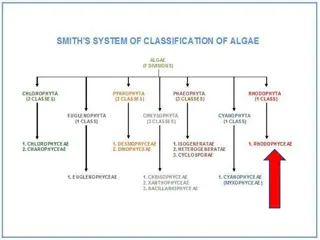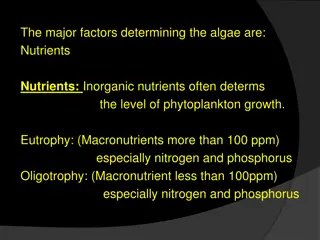Understanding Algae: General Characteristics, Occurrence, and Classification
Algae, studied in algology or phycology, are autotrophic organisms with chlorophyll, primarily found in aquatic environments. They exhibit a variety of structures, pigments, and reproduction methods. Algae are classified into 11 classes based on criteria such as pigmentation, reserve food, and thallus organization, showcasing the diversity and importance of these photosynthetic organisms.
Download Presentation

Please find below an Image/Link to download the presentation.
The content on the website is provided AS IS for your information and personal use only. It may not be sold, licensed, or shared on other websites without obtaining consent from the author. Download presentation by click this link. If you encounter any issues during the download, it is possible that the publisher has removed the file from their server.
E N D
Presentation Transcript
Algae Dr. Shinde A. S. SCS College, Omerga
General Characters The study of Algae is known as Algology or phycology. Algae are autotrophic organisms and they have chlorophyll. They are O2producing photosynthetic organisms that have evolved in and have exploited an aquatic environment. In Algae the plant body shows no differentiation into root, stem or leaf or true tissues. Such a plant body is called thallus. They do not have vascular tissues. The sex organs of this group of kingdom plantae are not surrounded by a layer of sterile cells.
Occurrence and Distribution Most of the algae are aquatic either fresh water or marine. The free floating and free swimming minute algae are known as phytoplanktons. Species that are found attached to the bottom of shallow water substratum are called Benthic. Some species of algae and fungi are found in association with each other are called Lichens. A few species of algae are epiphytes (i.e they live on another plant or another alga) and some of them are lithophytes (i.e they grow attached to rocks)
Thallus organization The thalli of algae exhibit a great range of variation in structure and organization.
Pigments Three types of Photosynthetic pigments are seen in algae. Chlorphylls Carotenoids Biliproteins. While chlorophyll a is universal in all algal classes, chlorophyll b,c,d,e are restricted to some classes of algae. The yellow, orange or red coloured pigments are called carotenoids. It includes the caroteins and the Xanthophylls. The water soluble biliproteins called phycoerythrin (red) and phycocyanin (blue) occur generally in the Rhodophyceae and Cyanophyceae. Pigmentation in algae is an important criterion for classification.
Reproduction Three common methods of reproduction found in Algae. Vegetative reproduction It lakes place by fragmentation or by the formation of adventitious branches. Asexual reproduction It takes place by means of different kinds of spores like Zoospores, Aplanospores and Akinetes. Sexual Reproduction Sexual reproduction involves fusion of two gametes. Isogamy It is the fusion of two morphologically and physiologically similar gametes.eg. Spirogyra and some species of Chlamydomonas . Heterogamy This refers to the fusion of dissimilar gametes. It is of two types- 1. Anisogamy morphologically dissimilar but physiologically similar. 2. Oogamy morphologically and physiologically dissimilar.
Classification F.E. Fritsch (1944-45) classified algae into 11 classes based on 1. Pigmentation 2. Reserve food 3. Flagellar arrangement 4. Thallus organization 5. Reproduction. The 11 classes of algae are: 1. Chlorophyceae 3. Chrysophyceae 5. Cryptophyceae 7. Chlromonodineae 9. Phaeophyceae 11. Myxophyceae 2. Xanthophyceae 4. Bacillariophyceae 6. Dinophyceae 8.Euglenophyceae 10. Rhodophyceae
Economic Importance Algae as Food: Algae are important as a source of food for human beings, domestic animals and fishes. Species of Porphyra are eaten in Japan, England and USA. Ulva, Laminaria, Sargassum and Chlorella are also used as food in several countries. Sea weeds (Laminaria, Fucus, Ascophyllum) are used as fodder for domestic animals. Algae in Agriculture: Various blue green algae such as Oscillatoria, Anabaena, Nostoc, Aulosira increase the soil fertility by fixing the atmospheric nitrogen. In view of the increasing energy demands and rising costs of chemically making nitrogenous fertilizers, much attention is now being given to nitrogen fixing bacteria and blue green algae. Many species of sea weeds are used as fertilizers in China and Japan.
Economic Importance Algae in Industry Agar agar : This substance is used as a culture medium while growing bacteria and fungi in the laboratory. It is also used in the preparations of some medicines and cosmetics. It is obtained from the red algae Gelidium and Gracilaria. A phycocolloid Alginic acid is obtained from brown algae. Algin is used as emulisifier in ice creams, tooth pastes and cosmetics. Idodine: It is obtained from kelps (brown algae) especially from speicies of Laminaria. Diatomite : It is a rock-like deposit formed on the siliceous walls of diatoms(algae of Chrysophyceae). When they die they sediment, so that on the seabed and lake bottom extensive deposits can be built up over long periods of time. The resulting diatomaceous earth has a high proportion of silica. Diatomite is used as a fire proof material and also as an absorbent.
Economic Importance Algae in space travel: Chlorella pyrenoidosa is used in space travel to get rid of Co2 and other body wastes. The algae multiplies rapidly and utilizes the Co2 and liberate 02 during photosynthesis. Single cell protein (SCP): Chlorella and Spirullina which are unicellular algae are rich in protein and they are used as protein source. Besides, Chlorella is a source of vitamin also. The rich protein and amino acid content of chlorella and. Sewage Disposal: Algae like Chlorella are grown in large shallow tanks, containing sewage. These algae produce abundant oxygen by rapid photosynthesis.
NOSTOC Empire Kingdom Subkingdom Negibacteria Phylum Cyanobacteria Class Cyanophyceae Subclass Nostocophycideae Order Nostocales Family Nostocaceae Genus Nostoc Prokaryota Bacteria
Characteristics Plant body thallose; micro- or macroscopic gelatinous, amorphous or spherical, later irregularly spherical, lobate. Smooth or warty on the surface, filamentous. Filaments within colony irregularly coiled and loosely or densely agglomerated, sometimes more gathered in peripheral layer. Sheaths around trichomes present, but visible usually only in the periphery of colony or in young colonies, wide, fine mucilaginous, confluent with colonial mucilage, sometimes yellowish-brown. Trichomes isopolar, of the same width along the whole length, cells cylindrical, barrel-shaped up to almost spherical (forming moniliform trichomes).
Characteristics Heterocytes solitary, develop in trichomes terminally or intercalary (their frequency or absence is dependent on nitrogen metabolism); Trichomes in principle metameric. Akinetes arise apoheterocytic, oval, little larger than cells. Almost all cells between heterocytes change successively in akinetes towards heterocytes.
Reproduction Cells divide crosswise. Reproduction by motile hormogonia, which differentiate from trichomes by disconnection at heterocytes, by dissociation of thallus and by akinetes, respectively.
CHARA Empire Kingdom SubkingdomViridiplantae InfrakingdomStreptophyta Phylum Charophyta Class Charophyceae Order Charales Family Characeae Tribe Chareae Genus Chara Eukaryota Plantae
Characteristics Chara cosmopolitan in fresh to slightly brackish water; endemic species present on all continents Plant body : Erect, branched plants mostly 30-100 cm long and usually calcified; attached by numerous rhizoids. Colorless rhizoids multicellular and branched. Alternating sequence of nodal and internodal cells developed from apical cell. Each apical cell derivative divides transversely and daughter cells develop into multicellular nodal complex with 6-12 peripheral cells and its internodal cell, respectively. Each node bears a whorl of 6-16 corticate or ecorticate determinate branchlets 2-many cells long.
Characteristics Cells mostly uninucleate, however, internodal cells with a few large irregular nuclei produced by amitosis. Cells interconnected with numerous plasmodesmata. Cytoplasm distinctly layered with external stationary layer with rows of helicoidally aligned chloroplasts (ectoplasm) and internal streaming layer with nuclei and mitochondria (endoplasm); cells with large central vacuole.
Asexual Reproduction Asexual reproduction by vegetative propagation from rhizoids and adventitious development from nodal cells of plants buried in sediments, or by bulbils (see Nitellopsis).
Sexual Reproduction Sexual reproduction always oogamous with gametes produced in complex, multicellular antheridia and oosporangia produced adaxially on branchlet nodes. Species unisexual or bisexual, in the former with single gametangium at each node. In bisexual plants gametangia mostly paired with the antheridium borne below oogonium; gametangia develop simultaneously or with antheridia first. Morphology of mature antheridia and sperm and oosporangia and oospores as described for Lamprothamnion or Nitella.
Sexual Reproduction Following fertilization compound oosporangial wall develops derived from both entheathing cells and fertilized oosphere, with outer calcified layer. Zygote germination associated with development of protonemal stage that undergoes divisions to form large and small cells. Primary axes develop as lateral branches of protonema. The life history is presumably zygotic, however, the position of meiosis not widely studied.
Life Cycle of Chara
Specialty Studies Chara spp. widely used as model systems in studies of ion transport and electrophysiology. Extracellular current patterns disrupted on exposure of cells to microtubule inhibitors, suggesting microtubular regulation of spatial patterns of plasma-membrane transport events.
BOTRYDIUM Empire Kingdom Subkingdom Harosa Infrakingdom Heterokonta Phylum Ochrophyta SubphylumPhaeista Infraphylum Marista Superclass Fucistia Class Xanthophyceae Order Botrydiales Family Botrydiaceae Genus Botrydium Eukaryota Chromista
Characteristics Thallus multicellular, globose aerial portion, 1-2 mm in diam., subtended by colorless rhizoidal siphons which penetrate soil. Outer wall of aerial structure toughened, thin peripheral layer of cytoplasm with many nuclei and discoid chloroplasts. Rhizoidal siphons little or profusely branched, without chloroplasts but with many nuclei. Botrydium is common and widespread, terrestrial on muddy banks of streams and ponds or on bare soil. Usually abundant and hiding underlying soil. Frequently encrusted with calcium carbonate.
Asexual Reproduction Asexual reproduction by cell contents cleaving into uni- or multinucleate protoplasts, rounding up and secreting wall to form aplanospores, Or entire cytoplasm forming a single- walled cyst. Hypnospores formed by any portion of cell separated by wall.
Sexual Reproduction In sexual reproduction entire cell can divide to form many (? about 40,000) heterokont- flagellated, pyriform zooids which fuse isogamously or anisogamously to form zygotes. Zooid also can develop parthenogenetically without fusing. The zygote develops directly into vegetative thallus.



